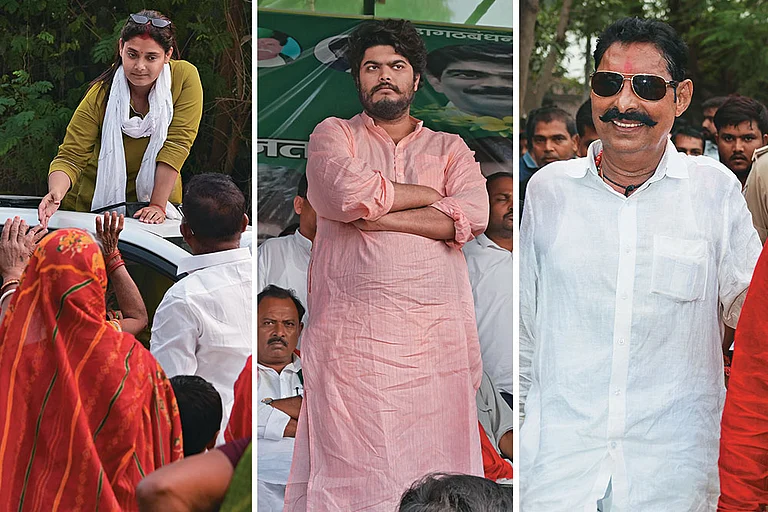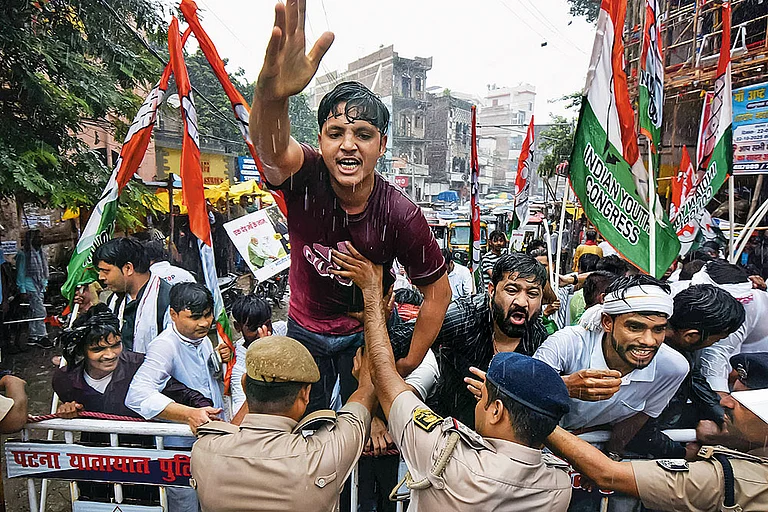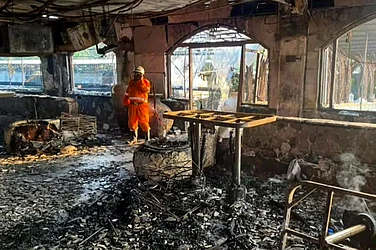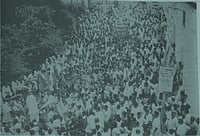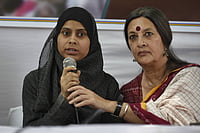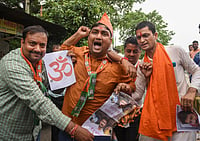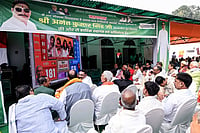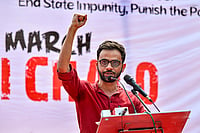
Dularchand, a Jan Suraaj worker, was gunned down in Patna’s Mokama on Thursday.
The incident occurred on the same day Prime Minister Narendra Modi invoked memories of the Lalu Yadav-era Jungle Raj during the late 90s to early 2000s.
After the brutal killing, Mokama is on edge, with some expressing a loss of faith in Bihar Chief Minister Nitish Kumar’s promise of governance and law & order.
Despite the rising crime rate in Bihar, Chief Minister Nitish Kumar — long celebrated as Sushasan Babu, the engineer who brought order to a lawless state — has managed to preserve the image of a disciplined, pragmatic leader. But the brutal murder of Dularchand Yadav, a locally influential Jan Suraaj Party organiser in Mokama, threatens to undo that legacy.
The killing has blurred the lines between Nitish Raj and Jungle Raj, reviving old fears and forcing Biharis to question whether good governance was ever more than an image, carefully curated and politically managed.
Fear Returns to Mokama
Hours after Yadav was cremated under heavy police presence on Friday evening, the air in Mokama, a town along the southern banks of the Ganga, hung thick with fear. Locals whispered of revenge and fresh clashes. The unease deepened after police booked Anant Singh, the JD(U)’s muscleman and once-feared strongman, along with several associates, on charges of murder.
An FIR, registered at Bhadaur police station, names Singh, his nephews Ranveer and Karmaveer Singh, and aides Chhotan and Kanjay Singh. They face charges under Sections 302 (murder), 120B (criminal conspiracy), 147/148 (rioting and armed assembly), and the Arms Act.
Eyewitnesses say the two rival groups — JD(U) supporters and Jan Suraaj workers — crossed paths in the Basawan Chak area, where a verbal altercation quickly turned violent. Within minutes, gunfire broke out. Dularchand was hit in the chest before his car was rammed and run over.
Unconfirmed reports later suggested he may not have died solely from gunshot wounds, fuelling anger and speculation across the region.
“People have stopped stepping out after dusk,” says shopkeeper Pramod Singh in Ghoswari Bazaar. “You never know which convoy will pass, and who will start firing.”
A Town on Edge
The Basawan Chak–Taal belt, where the killing occurred, now looks like a war zone. Police pickets guard entry points, and barricades stand where campaign jeeps once rolled. More than 150 personnel from the Bihar Military Police have been deployed. Although no formal curfew has been declared, residents have been advised to stay indoors.
“We are ensuring law and order during the election period,” said SSP Rajeev Mishra. “Patrolling has been intensified, and all political convoys are being monitored.”
Despite the reassurances, the mood remains grim.
“Every few hours, you hear sirens. It reminds us of the bad days,” says Rehana Khatun, a schoolteacher near Taal crossing. “This killing has reopened old wounds.”
In the surrounding villages, political activity has all but stopped. Women have withdrawn from evening meetings, and loudspeakers that once blared campaign songs now remain silent.
“Who will risk their life for a vote?” asks Rakesh Yadav, a 28-year-old Jan Suraaj volunteer. “They killed our leader in daylight. We’re scared, but also angry.”
For now, the Election Commission has sent additional observers to the Mokama–Barh belt. But locals say administrative calm rarely equals emotional peace.
Echoes of an Old Battle
For the people of Mokama, the violence feels like déjà vu. Two decades ago, the region was notorious for gang wars that shaped Bihar’s politics. Many of the gang leaders became legislators, commanding both loyalty and fear. Dularchand himself was once an RJD loyalist before joining Prashant Kishor’s Jan Suraaj, a movement that challenged Bihar’s entrenched power structures.
The FIR against Anant Singh adds another bloody chapter to Mokama’s long history of political killings. Known as “Chhote Sarkar,” Singh has faced dozens of criminal cases over the past three decades — from extortion to murder. Yet his hold on local politics remains unbroken.
“This is not just a murder. It’s a message,” says Piyush Priyadarshi, the Jan Suraaj candidate from Mokama. “Our workers are being targeted because we threaten the old order.”
At a candlelight vigil in Patna, Prashant Kishor accused Nitish Kumar’s government of allowing fear to return.
“Our worker was killed for daring to campaign where feudal power still decides politics,” he said. “If Anant Singh can roam free while our worker dies in daylight, what kind of democracy are we defending?”
The JD(U) dismissed the allegations as “politically motivated,” but the optics have already reinforced a troubling narrative — that Bihar, once the poster child for reform, is sliding back into lawlessness.
The Decline of the ‘Sushasan Babu’ Aura
For nearly twenty years, Nitish Kumar built his brand on one defining idea: that Bihar could be governed with efficiency and restraint. As Sushasan Babu, he was credited with rebuilding roads, curbing crime, and restoring faith in governance.
That image now appears frayed. His government’s subdued response to a series of high-profile killings — of political workers, businessmen, and women — has created an impression of fatigue, even complacency.
Just recently, Bihar has seen three more high-profile murders — Dularchand was the fourth— and behind closed doors, JD(U) insiders admit that Nitish’s focus has shifted. He is looking less at policing and is more worried about his political survival. With another election approaching, the chief minister seems preoccupied with managing alliances rather than criminals.
“Nitish seems tired,” observes Aneesh Ankur, a Patna-based political journalist. “He no longer commands fear or faith — only habit.”
The Data Behind the Decline
According to National Crime Records Bureau (NCRB) data for 2024, Bihar recorded a 16 per cent rise in murders and a 22 per cent increase in kidnappings over the previous year. Patna alone saw more than 600 incidents of armed robbery and extortion, the highest in a decade.
The surge is sharpest in Muzaffarpur, Nawada, Sitamarhi, and Patna rural, where political rivalry, unemployment, and gang networks intersect.
Officials in the state’s Home Department privately acknowledge that a shortage of police personnel, poor conviction rates, and political interference have weakened law enforcement.
“The old networks of musclemen and political financiers have revived,” says a senior IPS officer. “The police hesitate to touch them during election season.”
Governance In Bihar: Nitish Kumar’s Fading Promise
Two decades ago, Nitish Kumar asked Biharis to believe that governance could replace fear. That faith built his career. Today, as bodies pile up and public trust erodes, his legacy faces its toughest test yet.
On the streets of Mokama, where Dularchand Yadav was killed, a Jan Suraaj worker summed up the mood:
“Nitishji gave us light and roads, but the shadows have returned. You can fix electricity — not fear.”
As the investigation unfolds, the question haunting Bihar is no longer just who killed Dularchand, but whether Bihar ever truly escaped its old politics of power and blood.








.png?auto=format%2Ccompress&fit=max&format=webp&w=768&dpr=1.0)
